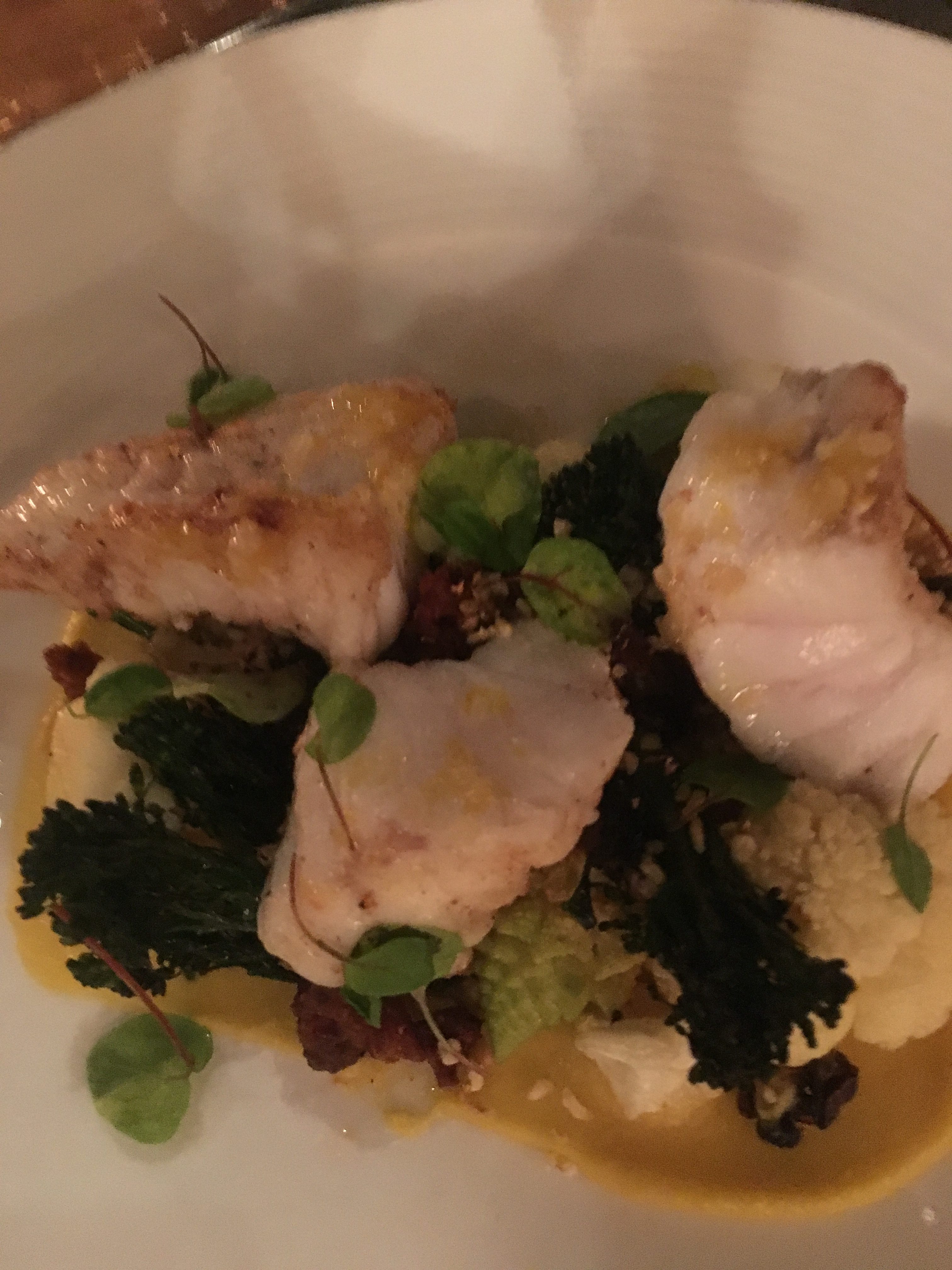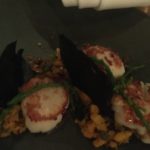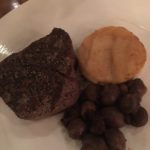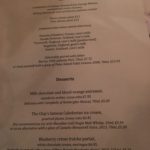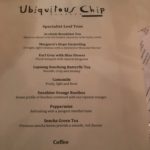We’re talking legendary stuff here, the restaurant known to many as the finest in Glasgow – though there is stiff competition nowadays and the Ubiquitous Chip, the star of Glasgow’s West End, prefers to rest on its laurels with tried and trusted dishes that have stood then test of time. For example, the menu proudly boasts that their venison haggis (known colloquially as “staggis”) with champit tatties, carrot crisp and neep cream, has been on the menu since 1971, perhaps with a little evolution along the way. Fact is that the heritage of serving Scottish cuisine here matters. As the website puts it:
“The Chip was opened by Ronnie Clydesdale on the 11th January 1971, at a time when Scottish cuisine was confined solely to the home. Chefs of the day knew only Italian or French cooking, and if you wanted to eat out in Glasgow your choice was limited. In the early years, to suggest that Scotland had a legitimate unique cuisine was an anathema. We had a vision to bring back Scottish cuisine, and to become the best place to eat in Glasgow.”
From day one The Chip (as I shall abbreviate the ironic name, and doubtless many before and since) drew its inspiration from regional Scottish dishes. Aunties, grannies and even folklore were a constant source of influence. Some thought us daft, and saw eating out for Glasgow and Scottish cuisine preposterous. Yet, some 40 years on Ronnie’s faith in our national cuisine has been embraced across the country, and Scottish produce is deservedly acclaimed as some of the best in the world.”
Evidently Ronnie succeeded where many have failed by virtue of several factors, one being location location location. The Chip occupies a block just off Great George Street in the heart of the West End (vibrant as London’s West End on a smaller scale), in which space they provide a pub and a brasserie as well as the restaurant.
The others may well include the ambience, of which more in a moment, te consistency and quality, events staged, decent service and that the Chip has established a “name” during the dismal years of the 70s and not relinquished its title. Yes, there are starred restaurants out in the wilds, but this may be the most popular fine dining spot in Scotland.
For me, it was a must-try occasion I’ve stored up for a good number of years. Not only to try the best Scotland could offer and see what the fuss was about, but to rate it subjectively in the Millward fine dining firmament. The restaurant is undeniably distinctive, being a very old whitewashed warehouse of a room with tables on two floors and cloistered in side rooms, walls lined with ancient farming tools that might once have been sold to rural Scottish farmers.
To my companion, the presence of greenery dangling down the black metal panels and struts reminded her uncomfortably of a children’s meal at one of the Rainforest Cafe branches, complete with awful burgers and bottomless fizzy drinks. All good reason to shudder, though I’m sure the Triffidesque foliage serves a valid purpose beyond being a talking point. The only one that springs to mind is to create an illusion of privacy around the tables, even if it does feel like eating in the jungle. Actually, the ambience of the Chip is warm, conducive and free of annoying bugbears, which is all you can ever ask of any restaurant.
A brief word to the wise before we start on the perils and pitfalls of modern dining. Bear in mind one thing though: as with all modern British cooking, the influence of France, Italy and indeed global “brands” has seeped in by osmosis, in technique, presentation, ingredients. For example, expect pasta to feature on “British” menus, a nod perhaps to how spag bol has become co-holder of the British national dish prize, though Glasgow has possibly the largest Italian community in the UK – so a nod or two in that direction is a reflection of contemporary Scotland. Restaurants need, in my humble estimation, to go easy on “concept” but keep eyes and ears open for what happens in their own neighbourhoods, what ingredients are tingling with freshness and excellence, what cultures influence the populace and what excites the tastebuds while staying true to traditions.
Not an issue at the Chip, though. Even the amuse bouche had a heartwarmingly Scottish feel, being a tiny cup of cumin-spiced parsnip veloute (ie. puréed sweet curried soup, a favourite of Empire days), of which I could happily have enjoyed a whole bowl. The menu is well-chosen, largely seasonal and includes dishes built to emphasis the fine quality of Scottish produce. In saying that, I’m assuming that monkfish is caught off Scottish waters rather than being imported from Cornwall, but then Ronnie’s place gives me confidence that provenance, food miles and supporting local producers matters.
For example, the Aberdeen Angus beef is proudly declared to be born, bred and eaten in Scotland, and as the finest exponent of grass-fed beef to be found anywhere is rightly announced with pride. A word too for a sizeable and distinguished wine list, which under different circumstances would repay delving and sampling. Having already sampled several drinks at the nearby Brel bar, a glass of sharp and tasty Chablis proved an excellent partner for her fish, while a rich but not resounding Chateauneuf-du-Pape was underwhelming at £17.25 for a small glass. Maybe the fruitier Malbec would have been a wiser choice to accompany my beef steak?
For starters she had said venison haggis, coming with a coating of neep cream to make it look like a miniature Christmas pudding, while the hunk of snow-white mash arrived with carrot crisps poking out of the top like Rudolf’s antlers. It was much enjoyed.
For myself I chose the pricier Orkney scallops, being four slices (each half a king scallop, I’d say) of well-seared shellfish, seaweed crisp, walnut and chestnut, plus the odd strand of unseasonal samphire wound around the assembly. What there was was excellent, though for £13.95 I wonder how expensive fresh scallops truly are. Apparently cheaper in most places, since you can typically get a small plate of them for under £10 even in decent restaurants.
The lady chose the monkfish, which came in meaty chunks with squash, roasted brassicas (served in a more customer-friendly way than my recent experience at Marriott’s Warehouse) and a saffron and cauliflower purée sauce. I didn’t sample any, but then that tells me she was determined to eat the contents, to the extent of turning down some of my beef fillet to prevent any dilution of the riot of flavours on her own plate.
I went for the classic main of the house, being half a pound of Angus fillet au poivre, carved as a thick and succulent steak, heading in the direction of a tornados – with peppercorns but without the Rossini. Rewind what I said above though: was this not the French equivalent of a 70s prawn cocktail, or merely an Scottish corruption of a French original?
Either way, it’s been served in a Scotch-French tradition here for a very long time and is delicious, though I expected more oomph from the sauce. After some discussion with the waiter I had asked for it to be cooked on the fringes between blue and rare, so full marks to the chef for nailing that very fine line to perfection.
It came with a small round cake of dauphinois and a puddle of braised mushrooms which must have served a purpose, though it’s hard to see what – all the more so since our keen young waiter was keen to plug the available sides. I chose a beef stovie, if only to satisfy my partner’s curiosity. In this case, the stovie was a conical mound of potato, carrot, peas and stewed beef, and very tasty too.
We passed on desserts and coffees, despite the best efforts of our waiter to sell more. As a list they were also leaning strongly to la France, complete with dessert wine with a strong seam of Scottish pairings:
Lemon and chocolate ganache, brown bread ice cream, hazelnut crumble £7.95 Delicious with Campbells of Rutherglen Muscat, 70ml, £5.00The Chip’s famous Caledonian oatmeal ice cream,
poached brambles, honey oats £6.45 We recommend you try with Macallan Gold, 35ml, £5.50 or as an alternative Castano Monastrell Dulce, 2013, 70ml, £5.50Blueberry creme fraiche parfait, white chocolate cream, meringues £6.95 Complimented by Rosa Regale Brachetto d’aqui, 2015, 125ml, £5.25
Spiced apple cake, milk sorbet, salted honey, buckwheat crumb £7.45 Try this with a glass of M. Chapoutier Muscat de Beaumes de Venise, 70ml, £6.00
Tonka bean mille feuille, pumpkin ice cream, pistachio £7.95
Try with a glass of Chateau Laville, Sauternes, 2009, 70ml, £7.95
While the honey oats, brambles and hazelnuts may remind you of the Highlands, the novelty comes in the form of tonka beans (Dipteryx odorata), which as I’m sure you all know are vanilla substitutes and are native to Latin America. Think I was tempted by the cheeses, which originated in England, Scotland, France and Holland.
All in all, a very welcome trip to the Chip. I think the restaurant prices are uppish and geared at the London Michelin-starred bracket (£35 for my main, excluding extra sides, plus that glass of wine), but unquestionably that is a premium charged for being the best in town and the ability to fill all covers twice over. Oh, and the strong emphasis on service, with a multitude of well-trained and attentive waiting staff members hovering there at your beck and call.
Nevertheless, and in spite of their 45 years of selling Scottish-French food to the good and affluent people of Glasgow, I don’t think the Chip should rest on its laurels – watch out for No 16, The Finnieston and Cail Bruich in the same market space, to name but three.

